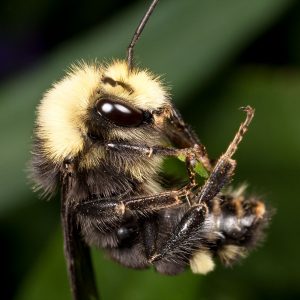 Help revive a cold or wet bee
Help revive a cold or wet bee
I’m often asked by folks what to do when one finds a cold, wet, or sluggish bee. The good news is that in many cases, you can help! And depending on the kind of bee, you may be helping many future bees, particularly if your bee is a queen bumble bee.
Spring and fall are often unpredictable weather and flower-wise, and sometimes you’ll find a bee who’s simply run out of steam and needs a helping hand. Unseasonable weather and a lack of flowers may trip them up, especially at these times of year. A foraging bumble bee is only ever about 40 minutes from starvation.

My first word of advice is don't panic. In most situations, you can help your bee (and you've almost certainly nothing to fear from an exhausted, cold, struggling bee)!
My next advice is to consider simply moving the bee onto a sunny bee-friendly flower (one close by, ideally where you see other similar bees foraging).
This works well for bees that are not too badly off, but it does require that they feel up to clinging onto a flower. Take care to move them gently (using a leaf works well), and observe them to see if they seem to recover. If your bee doesn't improve, keep reading.
Tap the closest link to your situation:
- Bee is struggling, not moving, or not flying away
- It's cold, raining, or the sun has almost set
- Bee is drowning (or partially drowned)
Tap to learn more about:
Tap the closest button to your situation:
A quick sugar-water fix
Bee Boost Elixir
- 1 part room temperature water (not boiled)
- 1 part sugar crystals (avoid brown sugar / honey)
Mix vigorously, then offer small portion
The first thing to do is to feed your bee. A cold, hungry bee is nothing to fear (in fact, bees are nothing to fear anyway, and you’re probably not too worried if you’re reading this page… but if you are, keep in mind that a cold sluggish bee is in no position or mood to sting… they’re simply hungry and cold, and will be happy for any help you provide)!
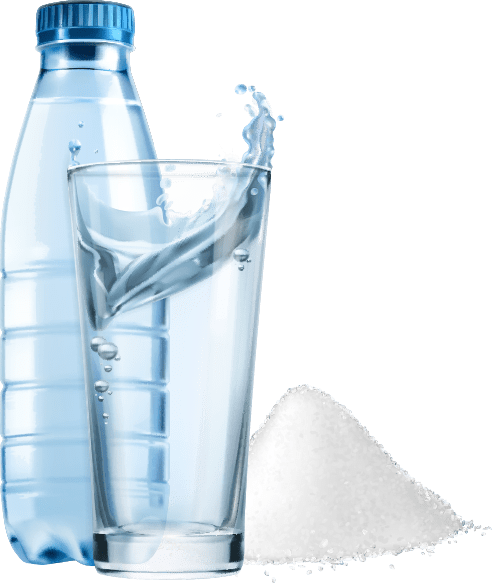
To feed your bee, mix up some organic granulated cane sugar or refined white sugar crystals (never brown sugar or honey) to create a sugar-water solution. A 1:1 mix (50%-50%) is appropriate, and this can be achieved simply by stirring the sugar rapidly in room temperature drinking water (lukewarm is fine, but not boiled).
Offer a small portion of this solution (just a few drops is plenty for a bee) in a shallow lid or teaspoon placed near the bee’s head. Alternatively, add a drop or two of sugar-water to some cut bee flowers placed near your bee (orchard blossoms, dandelions, or any pesticide-free blooming flowers nearby).
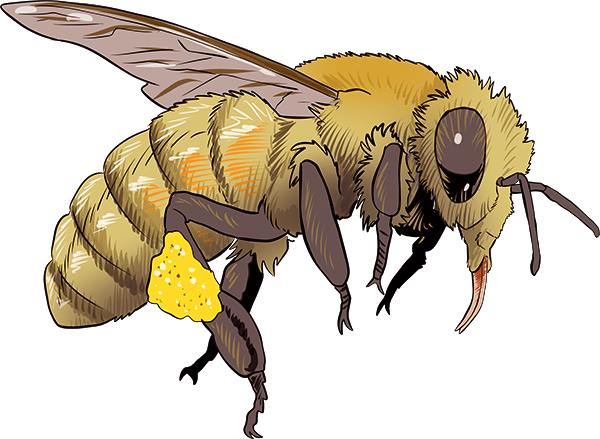
When drinking, you’ll see her long tongue extended like a straw below her head. Try placing drops of sugar-water mix directly beneath the tip of her tongue. If you do offer a small dish, make it impossible for your bee to fall clumsily into sugary water.
Honey Bee
Watch her tongue unfold from beneath. Often a light touch of the antennae signals to a bee that there's an energy drink nearby
Bumble Bee
Adding a pebble to the dish would avoid any chance of your bee falling in (but the bumble bee above managed just fine)!
Carpenter Bee
One trick is to add a drop of sugar water to a bee-friendly flower (this is an eastern carpenter bee with a damaged wing)
It often works within minutes
In most cases, your bee will recover quickly after drinking some sugar-water. Offering sugar-water often works even if it appears to you as though your bee is dead! A quick sugar-water boost should help your bee on its way to living another day 😌 It may take a few minutes or a few hours for her to recover, depending on how weak she was to begin with. Don’t be surprised to find your bee gone if you’re not keeping a constant eye on her!
Try warming up your bee too
Note that if it’s cold out (particularly if it's near or below 55°F / 13°C), you’ll speed your bee’s recovery by warming her up. You may do this by placing her in direct sunlight, by letting her sit on your warm skin (a hand or arm), or by bringing her indoors briefly (in a ventilated box) to warm up and drink some sugar-water.
Definitely stay within your comfort zone if you offer up your skin, but if you move slowly and unthreateningly, your bee may crawl right onto your hand or arm (she'll warm up through fabric too, so a dark-colored shirt is good if there's sun). Remember that a tired, sluggish bee is not likely to sting!
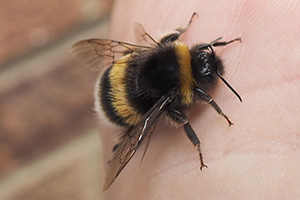
Shared with kind permission by reader John (read his full bee story)
Is your bee still not flying away?
If it's getting late (near sunset) or particularly cold or rainy, you may want to consider housing your bee overnight to protect her from predators while she is in a vulnerable state.
Bees do stay out overnight in odd places if they're caught out in bad weather, and they may wait (almost unmoving!) for several days while they await better weather. So if you're not comfortable housing your bee, look for some pesticide-free bee flowers nearby, and gently place your bee on these flowers. The best flowers are ones on which you've seen similar bees foraging, growing close to the ground (not far for a sluggish bee to fall), out of sight from predators like birds overhead, and bathed in sunlight in the days to come.
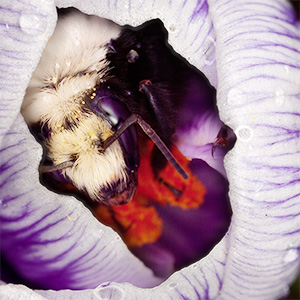
A bumble bee queen sleeps in a flower
This is my own story of a bumble bee queen who found the perfect spot to spend a series of nights in early spring. Safely tucked inside a crocus flower, she enjoyed a delicious energy bar, whose enclosing petals would open to the sky only once the sun hit! Read more
Types of sugar to avoid
It’s important to avoid brown sugar (which contains extra solids from molasses) and avoid maple syrup (which contains extra minerals), both of which are difficult for bees to digest. Also, do not use boiling water (when sugars caramelize at high heat, they can create indigestible and possibly bee-toxic compounds).
It can be tempting to reach for a few drops of local raw honey, but this can be a vector for spreading bee diseases, so to be safe, avoid feeding honey. If you’ve fed honey in the past, don’t worry about it too much though. Chances are you helped by giving the bee the quick energy boost it needed (flowers are also a conduit for bee diseases, so to some extent, bees are always taking risks when they sip nectar).
Avoid high fructose corn syrup at all costs, as compounds toxic to bees can be formed during manufacturing (as a result of overheating). And it should go without saying to avoid the fake stuff! I avoid conventional sugar because of pesticide usage (especially when sourced from sugar beets, which account for most sugar production and consumption in the United States; Monsanto licenses a Roundup Ready trait to sugarbeet seed companies).
Sugar-water is only for emergencies
The sugar-water solution I detail above should only be used in bee-saving situations. Sugar-water is not sufficient for bees’ nutritional needs long-term (they need all the other trace components of flower nectar for a balanced diet). Putting a dish of sugar-water out may attract bees, but it is not a good idea and it will not help bees in your area, however much they may appear to appreciate it as free food (it can also incense some bees and cause them to be more aggressive than they usually would be, as they compete for such an unusually easy food source).
Bees need pure water though! One of the best things you can do (especially on hot days) is to provide a large shallow dish of fresh water with pebbles in it so that bees may easily reach the water without falling into it. Honey bees in particular need water on hot days in order to cool their hives, and you may see a variety of pollinators and other insects coming to your water dish if you watch for any length of time!
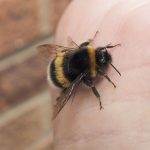
John’s story of the ‘Bee that Stayed’
Reader John first wrote to me in reply to my post about how to revive a cold, wet, or exhausted bee. In his words: “I can’t believe this, I love Bumble Bees, and when I find one in the garden lying there exhausted, I mix a bit of sugar with water and let them crawl on my hand have a drink, then they sleep for 3 minutes and fly off revitalized. Well. I found one lying on the lawn in a bad state, so I did my usual, NOW he has stayed on my hand and won’t go away, he stayed there whilst I mowed the lawn, and he is still here 1 hour later, he has stayed on my finger whilst I am typing, so I put him on a piece of kitchen roll next to me on the table.” Read more
Keeping your bee overnight
Sometimes you’ll find a bee in need of help in unseasonable weather (particularly in early spring, when bumble bee queens are emerging from hibernation). After offering sugar-water, you may decide that the best thing to do is to keep your bee safe overnight. If it’s late at night and cold (below 55°F / 13°C), or raining or even snowing outdoors, then releasing your bee may not be an option.
Base your decision on the time of day, the weather, and your observation of the bee… if it’s morning or afternoon, and she looks ready to go after sipping sugar-water, then she’ll likely want to bee on her way (even if it’s cool and a bit rainy). If it’s approaching evening or night, the weather is worsening, and the bee seems sluggish, her chances will improve by keeping her overnight (some people even end up keeping their bees several nights in a row, until the weather improves… just be sure to mimic as much as possible typical day/night light cycles and temperatures, so your bee doesn’t get confused).
Creating your own Air Bee-n-Bee
In this case, it’s time to make a cozy home for your bee for the night. A shoebox works well for this (with small holes punched in it to provide ventilation). Although we like soft things to lie on, it’s best not to add materials inside the box, as things like fabric may catch on a sluggish bee’s feet and make moving even more of a struggle for her.
Place her in the ventilated box, and provide a little greenery too so that it’s not just a bee inside a stark, empty box. Generally speaking (for overnight stays), I’d avoid placing flowers in the box, as they will lose their nectar fairly quickly, and may confuse a bee looking for food. However, I’ve heard of times when having flowers inside the box is just the thing to “cheer up” a bee and speed her on her way. If the time of day and weather is just “iffy” and might still be good enough for your bee to go out in, then try adding flowers into her box and seeing if she buzzes around sufficiently to bee on her way. If you’re still left with a sluggish bee, remove the flowers but put something natural of interest in the box for the night.
Place the box somewhere that’s not too warm and not too cold… err on the side of cooler, simply because it’s going to simulate their natural environment better. But certainly don’t allow the box to sit in freezing temperatures! Somewhere “in-between” such as a garage, utility room, or other sheltered and lightly-heated area is ideal. I'd recommend removing any dish of sugar-water overnight, so as not to attract ants or risk the bee falling in. You can put it back again in the morning.
Gorgeous red-tailed bumble bee queen shared with kind permission by reader Emily
Keep an eye on your bee
Check on your bee from time to time; if she’s full of energy and buzzing, she may well wish to take her chances outdoors. Bumble bee queens in particular are fairly well-equipped for unseasonable weather. Bumble bees are quite special in terms of their ability to decouple their flight muscles from their wings and vibrate (or “shiver”) in order to warm themselves up. But if it's totally inhospitable out (very cold or wet) and she's still full of energy and buzzing, simply move her box to a cooler location and she'll settle down.
Prepare to release your bee
If your bee seems comfortable and settled in her box, then wait to release her until the weather is more favorable (at least 55°F or 13°C). Bees are not particularly early risers! On the next day of decent weather, make sure your bee has had a little sugar-water for breakfast, and then leave her box open in a sunny warm spot outdoors. Release your bee near where you found her, ideally near flowers where you see other similar bees foraging. It can take anywhere between minutes and hours for her to feel ready to leave. If you hang around watching for a little while, you’ll likely see her buzz around her box a bit first, before finally taking off happily!
Sometimes bees stay a few days & nights
A few years ago I read the most charming story about someone’s encounter with a bumble bee queen and how she rescued it with sugar water and a night in a shoebox. Read her inspiring story on the Bumblebee Conservation Trust website:
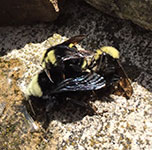
Hosting tiny guests at an Air Bee-n-Bee in San Francisco
Today I heard from Ann in San Francisco with a question after she found my post about how to revive a cold, wet, or exhausted bee. Astonishingly, a queen bumble bee—carrying three little worker bees, no less!—had sought out Ann’s help in the garden. In her words: “Hi, I have a queen bee that visited my back patio yesterday and she kept following me around and trying to get under a bag of potting soil…I moved the bag and then her…to under a sunny bush…she was then crawling back to me! So I put down my glove and she hopped on and I found a more protected area of the lawn where she spent the night. Today she is back with three small bumble bees on her back she is not moving and will not drink its going to get cold and windy soon…what do I do???” Read more
Rescuing bees from water
The easiest way to rescue a flailing bee from water is to use a leaf or some other object close-to-hand to scoop them up quickly. If you rescue your bee from water, the first thing to do is to put her in direct sunlight so she can dry out and warm up. While we generally prefer recovering in the shade, bees recover far faster in full sun.
Bees don't have lungs, instead they have a series of air sacs, with a number of spiracles (openings) along the sides of their bodies. You may see your bee's body pulsing as she recovers. This is the equivalent of us breathing heavily, and she's doing it to move more oxygen through her circulatory system.
Warm up and reenergize your bee
Avoid attempting to separate your bee's wings or correct other physical issues that appear amiss. Warm sun will help “reactivate” your bee, after which she can clean herself (if she needs) much more gently and effectively than us. It’s also a good idea to offer a few drops of sugar-water mix as above, if your bee doesn’t take off soon after being scooped up and drying off somewhere warm.
Offer a night's safe rest
If it’s too late at night for there to be any warmth or sunlight, then keep your bee overnight in a ventilated box, and release her the following morning.
Alternatively, look for bee-friendly flowers nearby, ideally low-growing (to avoid falls) and in sunlight come morning (also choose a spot where your bee won't stand out too much to a bird flying overhead)! Place your bee on these flowers, so that the following morning, she'll have breakfast ready as she awaits the warming day.
Preventing future accidents
Bees end up in pools of water for the most unsurprising of reasons: they hope for sips of water. Honey bees also use water to cool their hives in summer (they bring it back to their hives in a special stomach).
One way to help prevent bees falling into water is to offer a bee-safe drinking area (or several) nearby. Use something like a shallow dish, and place a number of pebbles to provide easy drinking perches. Keep the dish filled (ideally with filtered water), especially on hot days!
Tap to learn more about:
Knowing your bee helps
There are so many different kinds of bees, but when you find a bee, it’s very often one of the more common types. If it’s large and fuzzy, it’s probably a bumble bee. If it’s really large and fuzzy, it’s probably a queen bumble bee (especially in early spring and late fall). Honey bees are smaller by comparison, less fuzzy, and have that classic “striping” (light and dark bands) typically depicted in pictures of bees.
You can revive any kind of bee by offering sugar-water, moving them somewhere warmer (into direct sunlight, ideally), or even warming them up a bit gently with your breath. If it's a bumble bee and it’s late in the day or the weather is worsening (dropping below 55°F / 13°C, raining or snowing), you can also potentially keep your bee overnight in a ventilated box. Release your bee the following morning once the sun is up, and offer sugar-water again to give your bee an energetic start to her day!
These are all bumble bee queens:
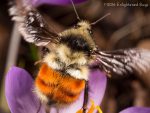
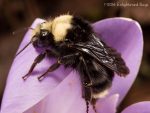
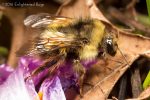
These are all honey bee workers:
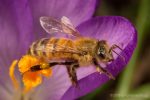
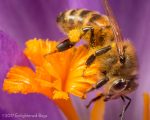
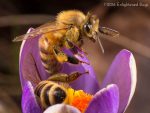
These are all carpenter bees:
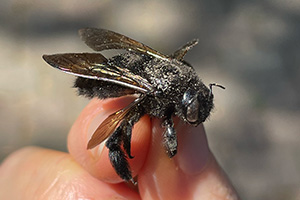
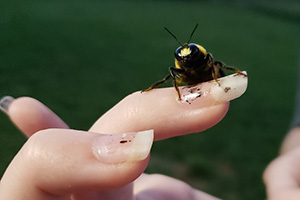
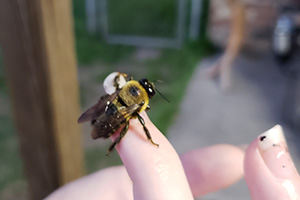
These are all wasps:
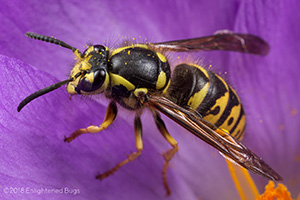
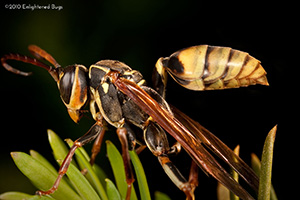
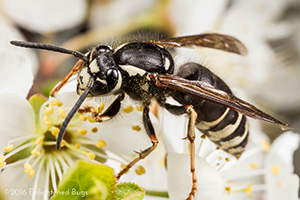
These are all flies that mimic bees:
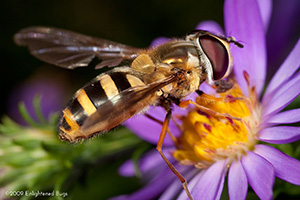
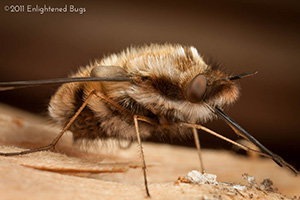
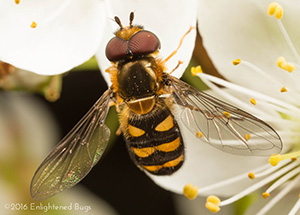
On wasps & flies
Bees are simply wasps that went vegetarian! Adult wasps drink nectar just like bees, never eating meat themselves. It's baby bees and wasps that need extra protein: for bees, protein-rich pollen makes the perfect larval food, whereas for wasps, protein-rich caterpillars and other prey are favored. Although wasps have a formidable reputation, they are good pollinators, and unlikely to sting unless defending their nest or young.
Some flies can be excellent "bee mimics". The way to tell a fly from a bee quickly is to look at their heads: flies have short, stubby antennae (compared to the long antennae of bees), and flies also tend to have larger eyes that meet at the top of their heads (though not always). Note that both flies and wasps can tolerate lower temperatures than bees as well.
Honey bees & water
Honey bees need to get back to their hives for the night, but bumble bees can stay out a night or two just fine. Honey bees are most often found in need of help when they’ve fallen into a pool of water on a warm day. Honey bees collect water in order to cool their hives, hence they face more dangers from falling into pools and ponds while trying to get to the water.
Help drowning bees by quickly scooping them out of the water, followed by placing the bee in direct sunlight to warm and dry it naturally. Offering sugar-water helps replace lost energy quickly.
If you consistently find yourself rescuing bees from pools of water near your home, try placing pebbles in a shallow dish of water nearby to provide them a safer place to drink, especially on hot days!
Early spring brings bumble bee queens
In early spring, large fluffy bumble bee queens are emerging from their winter hibernation. They’re searching for the earliest spring flowers and looking for the perfect underground burrow in which to start their colonies for the year (colonies that will number in the low hundreds of cute, fuzzy bumble bees). Sometimes they'll appreciate a little help, especially if they're nearly out of energy. Since they're relatively large bees, they need more energy simply to get off the ground.
Interrupted bumble bee queen hibernation
Bumble bee queens often hibernate in small holes that they dig into soil in order to stay safely undisturbed and protected from frost. They also hibernate in log piles and under leaf litter from time to time. Sometimes, they get disturbed in these places, such as by leaf blowers, fleeting bursts of unseasonably warm weather, or accidentally digging them up while gardening.
Ideally, if you find a large (likely queen) bumble bee in the depths of winter, avoid warming her up indoors, and instead try to put her back in the same place if possible. If for some reason that's not possible, then place her near to some easily-diggable soil or good bed of leaf-litter (north-facing banks work well, since hibernating bees are less likely to be awoken by the warming earth too early, and a bank of soil helps any rain run off safely).
For further information in these situations, the Bumblebee Conservation Trust has excellent tips for helping hibernating bumble bees.
Bumble bees "shiver" to warm up!
Although cold-blooded like all insects, bumble bees can generate their own heat by decoupling their wings from their flight muscles, then moving these without flying... giving the appearance of shivering! Bumble bees are more likely to get caught out in bad weather, since they take more chances with cooler temperatures (and even light rain). Honey bees, on the other hand, stay clustered warmly together in their hives on cold and rainy days.
Any mites you see are probably not harmful
The bee mites we read about in the news are a very specific type of mite (Varroa destructor) that only affects honey bees because of their unique life cycle. If your bee is a larger, fuzzier bee, chances are it has harmless bumble bee mites instead. Bumble bees often have harmless mites… they’re far smaller mites, and they’re not dangerous for the bee. They’re typically “hitchhiking” to the bumble bee’s nest from flowers, where the mites then feed on small bits of detritus around the nest.
So there’s typically no need to try to remove tiny mites from bees you find. The only time these much smaller mites can be a problem is in rare instances, when hundreds pile onto a bee at once, impacting its ability to fly. I’ve seen photos documenting this, but it is highly unusual. Honey bee mites are far larger by comparison… it would be like one of us having a rabbit-sized tick!
Reviving bees while out and about
When I go for long walks in spring, I carry a small vial of sugar-water with me in case I see a struggling bee in need. This way I can drop a few droplets onto something like a leaf or flower (right below the bee’s head), in order to give it a top-up of energy. If you don’t have sugar-water with you, you might instead try gently moving your bee (using a leaf or similar) onto nearby flowers where you (ideally) see other, similar bees foraging.
And if you'd love to carry sugar-water with you at all times just in case you find a bee in need, I’ve discovered the neatest solution, complete with protective keychain carrying case for the glass vial! Although UK-based, they'll ship elsewhere too (note that I have nothing to gain by linking, I simply think theirs is a neat product):
Beevive, inspired by a spontaneous encounter with a tired bee

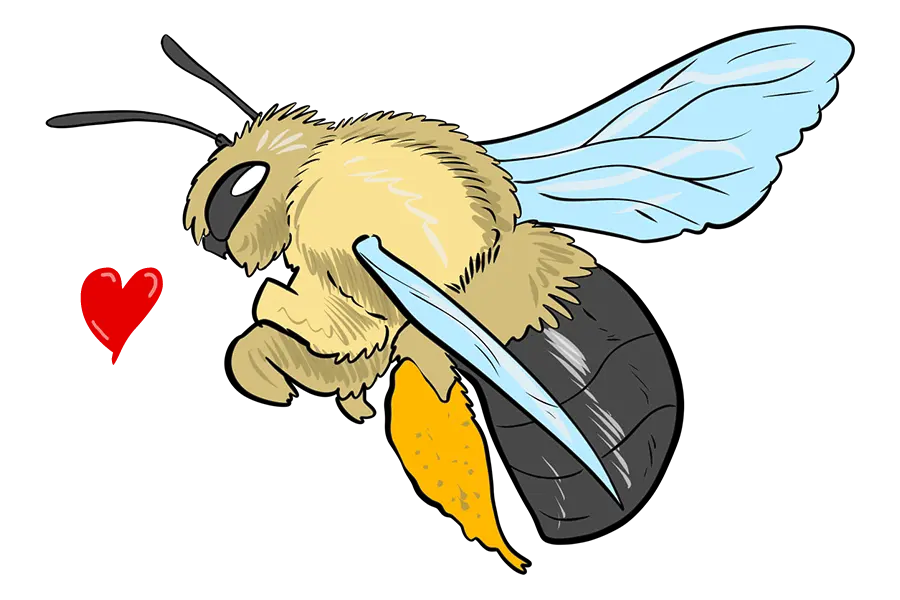
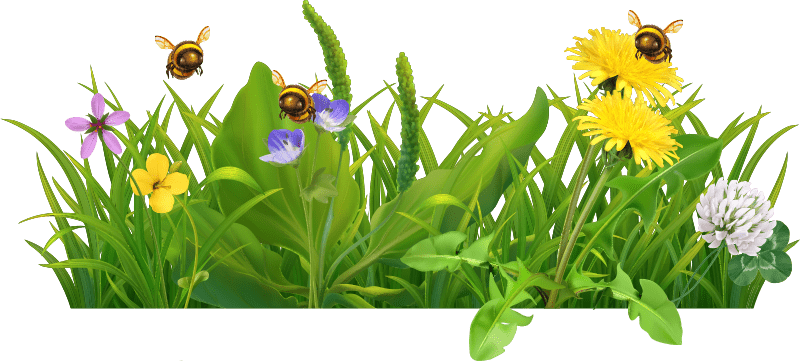


Still have a question about your bee?
I hope your bee is feeling better! If you're still concerned, drop your question here and I'll try to answer promptly (keep in mind I'm on the U.S. west coast, and sometimes I'm simply not around at the right time). The response to this page has been incredible, and I keep adding to this page based on hearing so many bee stories. While you wait, you might glance through recent questions & answers, yours may be answered too!
I only use the information you provide in order to help with your bee question. Read my full privacy policy.
Your email is important so that you know I've replied, and also in case we need to exchange photos of your bee.